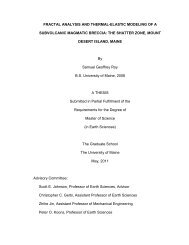Responses of Benthos to Changing Food Quality and Quantity, with ...
Responses of Benthos to Changing Food Quality and Quantity, with ...
Responses of Benthos to Changing Food Quality and Quantity, with ...
You also want an ePaper? Increase the reach of your titles
YUMPU automatically turns print PDFs into web optimized ePapers that Google loves.
<strong>Responses</strong> <strong>of</strong> <strong>Benthos</strong> <strong>to</strong> <strong>Changing</strong> <strong>Food</strong> <strong>Quality</strong> <strong>and</strong> <strong>Quantity</strong> 237<br />
the kinetics <strong>of</strong> deposit feeding are counterintuitively rapid due <strong>to</strong> the short<br />
gut residence times (30 min <strong>to</strong> 2 hr being <strong>of</strong>ten seen in shallow-water<br />
representatives) <strong>and</strong> large gut volumes (typically 30-80% <strong>of</strong> <strong>to</strong>tal body<br />
volume) imposed by the generally low food quality <strong>of</strong> sediments .<br />
To relate these ideas about animal activities <strong>to</strong> the usual biodiffusion<br />
coefficient (D,, in units <strong>of</strong> length squared per unit <strong>of</strong> time) Wheatcr<strong>of</strong>t et<br />
al . (in preparation) have decomposed it in<strong>to</strong> a step length <strong>and</strong> a frequency .<br />
Because step length is squared, this term dominates D,, . In burrowing, the<br />
typical distance moved by a sediment particle is small : a fraction <strong>of</strong> a burrow<br />
or body radius . In feeding, by contrast, gut length (more precisely mean<br />
distance from point <strong>of</strong> ingestion <strong>to</strong> point <strong>of</strong> egestion) is the appropriate<br />
length scale . Not only is the typical displacement distance by feeding thus<br />
much greater, we suggest that feeding is also the more frequent activity,<br />
assuring its dominance over burrowing in determining D,, .<br />
This bioturbation formalism can be applied <strong>to</strong> either conservative or<br />
reactive chemical species (Aller 1982) . To date, however, reaction terms<br />
inside animal guts have not been examined in the detail they deserve . What<br />
makes the deposit feeder gut a unique sedimentary environment is the<br />
otherwise rare combination <strong>of</strong> low gut oxygen levels (produced by microbial<br />
activity) <strong>with</strong> mechanical agitation . This combination is rare outside animal<br />
guts <strong>and</strong> is effective at speeding reactions over rates normally encountered<br />
in more tranquil anaerobic environments outside animal guts (Kristensen<br />
<strong>and</strong> Blackburn 1987) .<br />
A secondary purpose <strong>of</strong> ours is <strong>to</strong> challenge a virtually au<strong>to</strong>matic focus<br />
on successional time scales when dealing <strong>with</strong> benthic biological response<br />
<strong>to</strong> varying organic input . The reason for this au<strong>to</strong>matic focus is the relative<br />
abundance <strong>of</strong> data on these scales characteristic <strong>of</strong> anthropogenous organic<br />
inputs <strong>and</strong> scarcity <strong>of</strong> data on both larger <strong>and</strong> smaller spatial <strong>and</strong> temporal<br />
scales . In particular we question the notion that mechanistic, predictive<br />
underst<strong>and</strong>ing <strong>of</strong> aggregate phenomena, such as bioturbation, can be<br />
achieved <strong>with</strong>out a focus on the selective processes that operate on<br />
individuals . We will examine both steady <strong>and</strong> unsteady responses over a<br />
much broader range <strong>of</strong> scales than those encompassed by most studies <strong>of</strong><br />
organic loading-<strong>to</strong> highlight the lack <strong>of</strong> data <strong>and</strong> potential utility <strong>of</strong> models<br />
on these shorter <strong>and</strong> longer scales .<br />
BIOLOGICAL STRUCTURE AND FUNCTION<br />
Concepts <strong>of</strong> <strong>Food</strong> <strong>Quality</strong> <strong>and</strong> <strong>Quantity</strong><br />
Semantic difficulty runs rampant in discussions <strong>of</strong> organism response <strong>to</strong> food<br />
differences . To be useful, however, the amount <strong>of</strong> food supplied or available<br />
<strong>to</strong> an individual, population, or community must be expressed per unit <strong>of</strong>
















